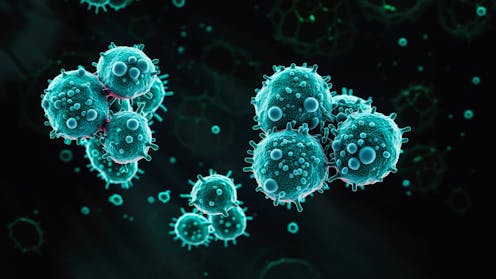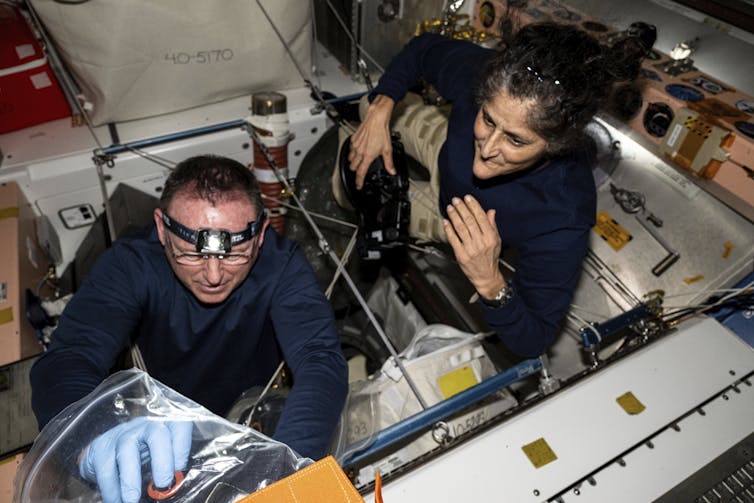Microgravity in space may cause cancer − but on Earth, mimicking weightlessness could help researche
Cells function differently under low gravity conditions. Rather than send lab samples to space, researchers are developing Earth-bound tools to more easily study microgravity’s effects on biology.

As space travel gains traction and astronauts spend increasing amounts of time in space, studying its effects on health has become increasingly critical.
Is space travel truly safe? Far from it – research has shown that the effects of space radiation and microgravity on the human body are both detrimental and long-lasting. Creating space conditions on Earth, however, could potentially help researchers treat cancer.
We are biomedical engineers studying how the body’s cells change under microgravity. Mimicking microgravity conditions on Earth allows researchers to study its effects without the need for space travel.
Lab research in space
Microgravity is a condition where gravity is extremely weak and objects are almost weightless. This occurs in space, where Earth’s gravity barely affects astronauts.
Being in a microgravity environment for an extended period of time can lead to several health issues, including bone loss, muscle weakness, face puffiness and heart changes. Even after astronauts return to Earth, their bodies do not completely go back to normal.
Studying how cells, organs and tissues respond to microgravity can help scientists better understand how to address any related harmful changes to the body. However, conducting research on lab samples in space faces significant challenges.

It is costly to launch equipment and samples, and experiments need to be planned around weightless conditions and the force of launch. Strict deadlines, limited access to space missions and dependence on astronauts to conduct experiments increase the complexity of these studies, making accuracy and cooperation crucial for success.
Accessing samples after they have been sent to space can also be difficult. They risk being damaged while in the harsh conditions of space and during transport back to Earth.
The process of planning and carrying out a lab study in space can be time-consuming, limiting the practicality of frequent experimentation.
Studying microgravity on Earth
To address these issues, scientists have developed equipment capable of simulating microgravity conditions on Earth.
One such device is the clinostat, a machine that continuously spins samples to mimic the effects of low gravity. By constantly rotating, it spreads the effects of gravity evenly so that the sample is “weightless” or close to it. To mimic the effects of microgravity, the clinostat must rotate at just the right speed – fast enough that the sample doesn’t react to gravity, but not so fast that it feels other strong forces.
Another method called dielectrophoresis places particles such as cells in a nonuniform electric field. Unlike a uniform electric field, which is the same strength and direction everywhere, a nonuniform electric field changes in strength or direction at different points. This uneven field causes cells to move based on differences in their electrical properties compared with the liquid surrounding them, enabling researchers to separate and study them. While this technique has been widely used on Earth, exploring its application in microgravity environments could allow researchers to more precisely manipulate particles and conduct research not feasible under Earth’s gravity.
Tools such as clinostats and dielectrophoresis provide an easier, cheaper and faster way to study microgravity’s effects on cells compared with space missions. They are cost-effective and portable, requiring less expensive equipment and a smaller volume of samples to quickly generate reliable data.
Microgravity and cancer
While microgravity can cause cancer, it could also potentially help researchers better understand and treat cancer.
Cancer is one of the most challenging diseases to treat because it evolves rapidly and often becomes resistant to available treatments. By observing cancer cells in microgravity, researchers can study how they grow, divide and respond to drugs under different conditions. In simple terms, we are taking cancer cells out of their comfort zone to see how they react to an unknown environment.
For example, researchers have observed that cancer cells have improved survival under microgravity. They also saw changes to their electrical properties. Other studies have shown that microgravity can alter immune cell function and how cells communicate with each other.
Our team and others hypothesize that cancer cells may respond more effectively to certain drugs when exposed to a weightless environment. We’re looking into whether we can use microgravity to manipulate cancer cells to behave less aggressively and become more vulnerable to treatment.
This research is still in its infancy. But if successful, these insights could help researchers develop new treatments that are more effective back here on Earth.
The authors do not work for, consult, own shares in or receive funding from any company or organization that would benefit from this article, and have disclosed no relevant affiliations beyond their academic appointment.
Read These Next
New materials, old physics – the science behind how your winter jacket keeps you warm
Winter jackets may seem simple, but sophisticated engineering allows them to keep body heat locked in,…
West Antarctica’s history of rapid melting foretells sudden shifts in continent’s ‘catastrophic’ geo
A picture of what West Antarctica looked like when its ice sheet melted in the past can offer insight…
As DOJ begins to release Epstein files, his many victims deserve more attention than the powerful me
Powerful men connected to Jeffrey Epstein are named, dissected and speculated about. The survivors,…






